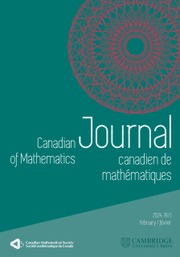Article contents
Schreier families and  $\mathcal {F}$-(almost) greedy bases
$\mathcal {F}$-(almost) greedy bases
Published online by Cambridge University Press: 14 June 2023
Abstract
Let  $\mathcal {F}$ be a hereditary collection of finite subsets of
$\mathcal {F}$ be a hereditary collection of finite subsets of  $\mathbb {N}$. In this paper, we introduce and characterize
$\mathbb {N}$. In this paper, we introduce and characterize  $\mathcal {F}$-(almost) greedy bases. Given such a family
$\mathcal {F}$-(almost) greedy bases. Given such a family  $\mathcal {F}$, a basis
$\mathcal {F}$, a basis  $(e_n)_n$ for a Banach space X is called
$(e_n)_n$ for a Banach space X is called  $\mathcal {F}$-greedy if there is a constant
$\mathcal {F}$-greedy if there is a constant  $C\geqslant 1$ such that for each
$C\geqslant 1$ such that for each  $x\in X$,
$x\in X$,  $m \in \mathbb {N}$, and
$m \in \mathbb {N}$, and  $G_m(x)$, we have
$G_m(x)$, we have  $$ \begin{align*} \|x - G_m(x)\|\ \leqslant\ C \inf\left\{\left\|x-\sum_{n\in A}a_ne_n\right\|\,:\, |A|\leqslant m, A\in \mathcal{F}, (a_n)\subset \mathbb{K}\right\}. \end{align*} $$
$$ \begin{align*} \|x - G_m(x)\|\ \leqslant\ C \inf\left\{\left\|x-\sum_{n\in A}a_ne_n\right\|\,:\, |A|\leqslant m, A\in \mathcal{F}, (a_n)\subset \mathbb{K}\right\}. \end{align*} $$ $G_m(x)$ is a greedy sum of x of order m, and
$G_m(x)$ is a greedy sum of x of order m, and  $\mathbb {K}$ is the scalar field. From the definition, any
$\mathbb {K}$ is the scalar field. From the definition, any  $\mathcal {F}$-greedy basis is quasi-greedy, and so the notion of being
$\mathcal {F}$-greedy basis is quasi-greedy, and so the notion of being  $\mathcal {F}$-greedy lies between being greedy and being quasi-greedy. We characterize
$\mathcal {F}$-greedy lies between being greedy and being quasi-greedy. We characterize  $\mathcal {F}$-greedy bases as being
$\mathcal {F}$-greedy bases as being  $\mathcal {F}$-unconditional,
$\mathcal {F}$-unconditional,  $\mathcal {F}$-disjoint democratic, and quasi-greedy, thus generalizing the well-known characterization of greedy bases by Konyagin and Temlyakov. We also prove a similar characterization for
$\mathcal {F}$-disjoint democratic, and quasi-greedy, thus generalizing the well-known characterization of greedy bases by Konyagin and Temlyakov. We also prove a similar characterization for  $\mathcal {F}$-almost greedy bases.
$\mathcal {F}$-almost greedy bases.
Furthermore, we provide several examples of bases that are nontrivially  $\mathcal {F}$-greedy. For a countable ordinal
$\mathcal {F}$-greedy. For a countable ordinal  $\alpha $, we consider the case
$\alpha $, we consider the case  $\mathcal {F}=\mathcal {S}_{\alpha }$, where
$\mathcal {F}=\mathcal {S}_{\alpha }$, where  $\mathcal {S}_{\alpha }$ is the Schreier family of order
$\mathcal {S}_{\alpha }$ is the Schreier family of order  $\alpha $. We show that for each
$\alpha $. We show that for each  $\alpha $, there is a basis that is
$\alpha $, there is a basis that is  $\mathcal {S}_{\alpha }$-greedy but is not
$\mathcal {S}_{\alpha }$-greedy but is not  $\mathcal {S}_{\alpha +1}$-greedy. In other words, we prove that none of the following implications can be reversed: for two countable ordinals
$\mathcal {S}_{\alpha +1}$-greedy. In other words, we prove that none of the following implications can be reversed: for two countable ordinals  $\alpha < \beta $,
$\alpha < \beta $,  $$ \begin{align*} \mbox{quasi-greedy}\ \Longleftarrow\ \mathcal{S}_{\alpha}\mbox{-greedy}\ \Longleftarrow\ \mathcal{S}_{\beta}\mbox{-greedy}\ \Longleftarrow\ \mbox{greedy}. \end{align*} $$
$$ \begin{align*} \mbox{quasi-greedy}\ \Longleftarrow\ \mathcal{S}_{\alpha}\mbox{-greedy}\ \Longleftarrow\ \mathcal{S}_{\beta}\mbox{-greedy}\ \Longleftarrow\ \mbox{greedy}. \end{align*} $$
MSC classification
- Type
- Article
- Information
- Copyright
- © The Author(s), 2023. Published by Cambridge University Press on behalf of The Canadian Mathematical Society
Footnotes
The second author acknowledges the summer funding from the Department of Mathematics at the University of Illinois Urbana–Champaign.
References
- 1
- Cited by



